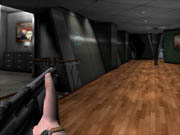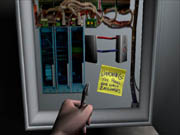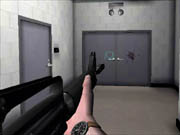As you can probably guess, Die Hard: Nakatomi Plaza is a first-person shooter based on the classic Bruce Willis action flick, Die Hard. The game attempts to re-create many of the movie's environments, characters, and one-liners throughout 30 or so single-player levels, and while it succeeds at capturing some of the bare essence of Die Hard in its action scenes, a number of problems with the controls, the graphics, and the enemy AI keep it from being anything more than a mediocre game.

In Die Hard: Nakatomi Plaza, you play as John McClane, a down-on-his-luck NYPD detective who travels to Los Angeles in an attempt to reconcile with his estranged wife at her company's Christmas party, which is being held in a massive and ultramodern 40-story skyscraper: Nakatomi Plaza. Soon after McClane's arrival, a group of terrorists takes over the building, severs its communications lines with the outside world, and plots to kill all the hostages in an attempt to make out with millions of dollars from the company's central vault. With his wife in danger, McClane takes it upon himself to single-handedly stop the terrorists using little more than his standard-issue Beretta and a Zippo lighter. All of the movie's memorable characters, including Sgt. Al Powell, Argyle, Harry Ellis, Holly Gennero, and Hans Gruber make an appearance in the game, and its plot unfolds through a series of in-game cutscenes that use many of the same camera angles as those in the movie.
The game will take you between 10 and 15 hours to finish, significantly longer than the movie's running time of two hours and 11 minutes. To flesh out the game's plot, the designers have added some sequences and missions that obviously weren't part of the movie. While this might seem like a good idea on paper, in practice, the new challenges facing John McClane don't seem to fit in with the whole Die Hard experience. Some of these new missions involve McClane crawling around in sewers, escorting members of a SWAT team around the building, and rescuing hostages from an inferno. What's more, the addition of these new levels causes the plot of the game to fall apart. For instance, when McClane first radios Sgt. Powell, he tells him that the building was taken over by about a dozen terrorists and that he's already "taken care of " a couple of them. While this stays true to the movie's plot, by the time you call Powell in the game, you've already killed about 20 of the terrorists. In fact, by the time you finish Nakatomi Plaza, you'll have run into nearly 100 enemies--and that's about 10 times the number of terrorists in the movie. Additionally, you're never given any sense of what you're supposed to be doing in each level. The cutscenes mirror only certain movie scenes and don't give you any direction at all. The only way to figure out what you're supposed to be doing is by bringing up an objectives window, and you're never informed of when this window is updated with completed or new objectives.

Nakatomi Plaza uses typical first-person shooter controls, though it deviates from the standard conventions of the genre a bit. Specifically, you move a lot slower in this game than you do in most shooters. There is an always-run option, but using it drains your stamina, which you'll need to do simple things, like jumping. Your stamina slowly regenerates, and it's denoted by a "lung meter" in the lower left-hand corner of the screen, where two other meters--health and morale--are also located. Supposedly, McClane's morale affects the way that hostages and enemies react to you, though there seems to be no notable differences in their behavior within the game. In fact, for the most part, almost all the enemies you'll run into will display a substandard level of intelligence. They'll usually stand perfectly still--sometimes at point-blank range--while you shoot them, and vice versa. Occasionally, you'll catch a terrorist shooting from around a corner or ducking behind a solid object, but those instances seem to happen infrequently.

The game's weapons are also problematic. Like in the movie, McClane has to depend on his Beretta and an MP5 submachine gun that he'll acquire from a dead terrorist, though the game adds a Steyr Aug assault rifle, a Colt M4A1 assault rifle, an M60 machine gun, and a few flash grenades that you can pick up in the later levels. While these new weapons are clearly designed to keep the shooting from getting repetitive, you'll be extremely hard-pressed to find any ammunition for them. In fact, despite having the other weapons on hand, you'll hardly ever use anything other than the MP5, which is all the more frustrating when you consider how inaccurate that gun is in the game. The MP5 is widely accepted to be the world's most accurate submachine gun, yet it has the recoil of a cannon and the accuracy of a spit wad in Die Hard: Nakatomi Plaza.
Nakatomi Plaza is powered by the LithTech 2.0 3D engine. But unlike the visually impressive No One Lives Forever and Aliens Versus Predator 2, both of which used the LithTech engine to good effect, Nakatomi Plaza's graphics are substandard compared with most other currently available shooters. While many of the game's levels look more or less like their respective movie environments, they're often rather blocky and skinned with low-resolution textures. Likewise, the character models are simple, and their movements--especially facial animations--seem rigid and unnatural. This becomes especially evident during the cutscenes, where close-ups of the characters clearly reveal these flaws. Nakatomi Plaza also suffers from some collision-detection issues, like dead bodies clipping through stairs or your own character clipping clean through an air duct in one of the later levels. And while the weapon models look pretty good, some of the special effects in the game--particularly the fire--look downright filthy. All of this makes it seem particularly peculiar that the game runs at such a horrible frame rate--whenever there are more than two enemies onscreen, the action becomes extremely choppy. This might be expected of a visually stunning game that makes use of all the latest rendering techniques, but Nakatomi Plaza is no feast for the eyes, so the fact that it runs slow on a Pentium III 933MHz machine with a GeForce 3 video card is unacceptable.

There are several musical scores that play throughout the game, and they increase in tempo whenever there's any action. The soundtrack itself isn't anything to write home about, but it does have a signature 1980s ring to it, and that fits a game like Nakatomi Plaza just fine. It's no great surprise that the dialogue in Nakatomi Plaza isn't done by the original actors, though for the most part, the in-game impersonators for John McClane, Hans Gruber, and Sgt. Powell do a fairly convincing job of sounding like Bruce Willis, Alan Rickman, and Reginald VelJohnson, respectively. But the voices for the minor characters are just plain horrible. The terrorists sound like schoolyard impersonations of Saturday Night Live's Hans and Frans, while Joe Takagi's character is voiced with an Asian accent that's so fake it'll make you cringe. Other sound effects, like weapon gunfire, are passable, though your MP5 sounds surprisingly muted.
While creating an action game based on the events of Die Hard seems like a logical endeavor, it doesn't work out in the case of Nakatomi Plaza. Fans of the movie might enjoy reliving some of McClane's memorable battles, but that novelty will wear off sooner rather than later. And its severe problems with the frame rate and the AI, as well as the lack of any replay value or multiplayer options, keep Nakatomi Plaza from being recommendable to first-person shooter fans. Even with its cheap $30 price tag, only the most die-hard Die Hard fans should pick up this game.
Editor's note 05/08/02: This review originally stated that Die Hard: Nakatomi Plaza uses the latest version of the LithTech 3D engine, when in fact it uses the slightly older version 2.0 of the LithTech technology. GameSpot regrets the error.